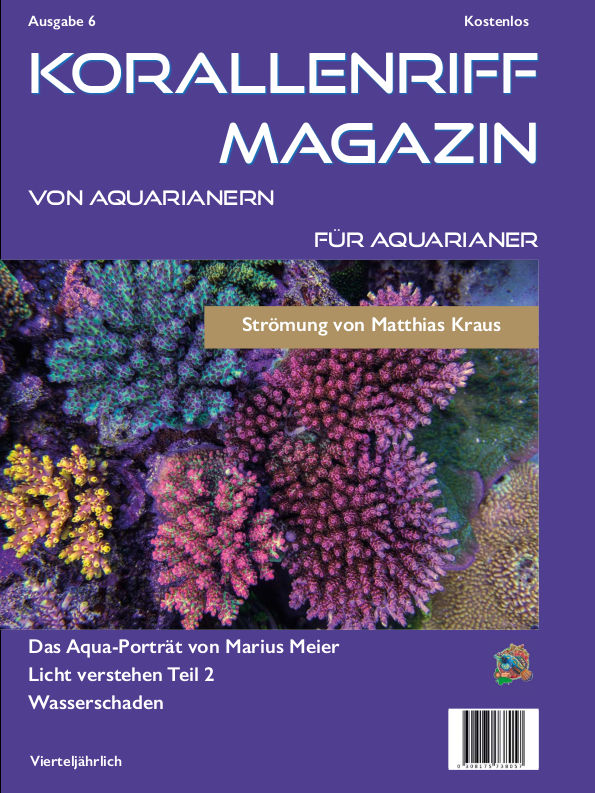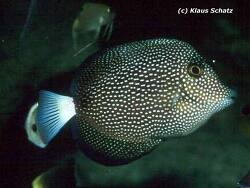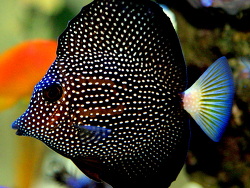Info
(Valenciennes, 1835)
The Spotted or Gem tang is the most expensive surgeonfish. Almost exclusively imported from Mauritius it is very rare in the marine aquaristic trade und fetches prizes in the four-digit range.
Regarding its husbandry its care requirements are similar to those of other Zebrasoma species, e.g. plenty of swimming space, a well-structured reef with many crevices to hide and sleep at night, highly oxygenated water and a predominately herbivore diet consisting of different macro algae supplemented by some frozen fare as mysid shrimps, krill etc.
Due to the distinct territorial behaviour of the Spotted tang towards conspecifics, fishbase.org recommends to keep it solitary, other sources, however, say that the Spotted tang may be kept successfully with other surgeonfish species.
Synonym:
Acanthurus gemmatus Valenciennes, 1835
Classification: Biota > Animalia (Kingdom) > Chordata (Phylum) > Vertebrata (Subphylum) > Gnathostomata (Superclass) > Pisces (Superclass) > Actinopterygii (Class) > Perciformes (Order) > Acanthuridae (Family) > Zebrasoma (Genus) > Zebrasoma gemmatum (Species)
The surgeonfishes (Acanthuridae), popular in marine aquaristics, are also called surgeonfishes.
They have horn-like blades in front of the tail root, they use as mainly defensive weapon (defense) against predators, but this sharp weapon is also used in fights among themselves.
Deep cuts in the body of opponents can cause permanent injuries, but often death occurs immediately.
If surgeonfishes are to be kept in pairs in an aquarium, fights between the fishes can be the order of the day, we could observe this several times with the very popular Hawaiian surgeonfish (Zebrasoma flavescens).
The scalpel-like blades can cause deep cuts, this is also true for the careless aquarist who wants to touch or catch the fish with unprotected hands.
Another problem can occur if one wants to catch surgeonfish with a landing net and transfer them after catching, the horn blade can easily get caught in the net.
Caution: Careless handling of the animal can cause deep cuts!
The Spotted or Gem tang is the most expensive surgeonfish. Almost exclusively imported from Mauritius it is very rare in the marine aquaristic trade und fetches prizes in the four-digit range.
Regarding its husbandry its care requirements are similar to those of other Zebrasoma species, e.g. plenty of swimming space, a well-structured reef with many crevices to hide and sleep at night, highly oxygenated water and a predominately herbivore diet consisting of different macro algae supplemented by some frozen fare as mysid shrimps, krill etc.
Due to the distinct territorial behaviour of the Spotted tang towards conspecifics, fishbase.org recommends to keep it solitary, other sources, however, say that the Spotted tang may be kept successfully with other surgeonfish species.
Synonym:
Acanthurus gemmatus Valenciennes, 1835
Classification: Biota > Animalia (Kingdom) > Chordata (Phylum) > Vertebrata (Subphylum) > Gnathostomata (Superclass) > Pisces (Superclass) > Actinopterygii (Class) > Perciformes (Order) > Acanthuridae (Family) > Zebrasoma (Genus) > Zebrasoma gemmatum (Species)
The surgeonfishes (Acanthuridae), popular in marine aquaristics, are also called surgeonfishes.
They have horn-like blades in front of the tail root, they use as mainly defensive weapon (defense) against predators, but this sharp weapon is also used in fights among themselves.
Deep cuts in the body of opponents can cause permanent injuries, but often death occurs immediately.
If surgeonfishes are to be kept in pairs in an aquarium, fights between the fishes can be the order of the day, we could observe this several times with the very popular Hawaiian surgeonfish (Zebrasoma flavescens).
The scalpel-like blades can cause deep cuts, this is also true for the careless aquarist who wants to touch or catch the fish with unprotected hands.
Another problem can occur if one wants to catch surgeonfish with a landing net and transfer them after catching, the horn blade can easily get caught in the net.
Caution: Careless handling of the animal can cause deep cuts!







 mortenN
mortenN




















